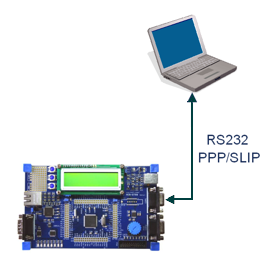|
||
| Products Download Events Support Videos | ||
Technical Support
On-Line Manuals
RL-ARM User's Guide (MDK v4)
Cable Connection
If you want to connect the embedded device directly to a computer, you must use the Null Modem driver. The figure belows shows an overview of a directly connected system.
However, RL-TCPnet's Null Modem driver supports two different procedures for establishing the null modem serial link with the computer:
-
Windows Direct Serial Link. This is a non-modem link.
This system requires the exchange of string tokens between the
computer and the embedded device before the PPP link can be
negotiated. The SLIP link needs no negotiation because SLIP is a
simple protocol over a serial line.
The Windows client sends the string "CLIENT". The Keil evaluation board must then send the string "CLIENTSERVER". When operating as a server, the Keil evaluation board must send the string "CLIENT". The Windows client must respond with the string "CLIENTSERVER".
This string exchange must occur before Windows allows the PPP connection to proceed. This string exchange is peculiar to Windows and is not required by other hosts. -
Windows Standard Modem Link. In this system, the Null
Modem driver simulates an external modem. The PPP source must
also be modified to operate with the Windows direct serial
driver. It requires the exchange of modem command strings between
the computer and the evaluation board before the PPP link can be
negotiated. The strings to be exchanged are shown in the table
below.
Windows Command Reply Description AT\r OK\r Attention Command ATE0V1\r OK\r Set No echo and Verbose Result reply AT\r OK\r Attention Command ATS0=0\r OK\r Disable Modem Auto Answer AT\r OK\r Attention Command ATE0V1\r OK\r Set No echo and Verbose Result reply AT\r OK\r Attention Command ATDTxxxxxxx\r CONNECT\r Dial Target number: xxxxxxx After the "CONNECT" string is received, Windows starts the PPP negotiations and user authentication.
ProductsDevelopment Tools |
Hardware & Collateral |
Downloads |
Support |
Contact |

